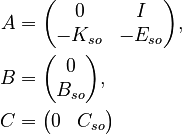(Edit SLICOT link) |
(Edit SLICOT link) |
||
| Line 22: | Line 22: | ||
==Data== |
==Data== |
||
| − | The system matrices <math>A</math>, <math>B</math>, <math>C</math> are available from the [ |
+ | The system matrices <math>A</math>, <math>B</math>, <math>C</math> are available from the [https://www.slicot.org/20-site/126-benchmark-examples-for-model-reduction SLICOT benchmarks] page: [https://www.slicot.org/objects/software/shared/bench-data/build.zip build.zip] and are stored as MATLAB [https://www.mathworks.com/help/matlab/import_export/mat-file-versions.html .mat] file. |
Here is [https://www.python.org Python] code for loading the matrices (<math>A</math> is stored as a sparse matrix that is mostly full and <math>C</math> is stored as an array of 8-bit unsigned integers): |
Here is [https://www.python.org Python] code for loading the matrices (<math>A</math> is stored as a sparse matrix that is mostly full and <math>C</math> is stored as an array of 8-bit unsigned integers): |
||
Revision as of 13:49, 30 August 2023
Description: Motion Problem in a Building
This benchmark models the displacement of a multi-story building for example during an Earthquake. More details can be found in [1] and [2], [3].
Earthquake Model
Origin
This benchmark is part of the SLICOT Benchmark Examples for Model Reduction[3].
Data
The system matrices  ,
,  ,
,  are available from the SLICOT benchmarks page: build.zip and are stored as MATLAB .mat file.
are available from the SLICOT benchmarks page: build.zip and are stored as MATLAB .mat file.
Here is Python code for loading the matrices ( is stored as a sparse matrix that is mostly full and
is stored as a sparse matrix that is mostly full and  is stored as an array of 8-bit unsigned integers):
is stored as an array of 8-bit unsigned integers):
import numpy as np from scipy.io import loadmat mat = loadmat('build.mat') A = mat['A'].toarray() B = mat['B'] C = mat['C'].astype(np.float_)
The  represents a second-order system
represents a second-order system
as
Here is Python code for checking the structure and extracting the second-order matrices:
n = 48 n2 = n // 2 assert np.all(A[:n2, :n2] == 0) assert np.all(A[:n2, n2:] == np.eye(n2)) assert np.all(B[:n2] == 0) assert np.all(C[:, :n2] == 0) Eso = -A[n2:, n2:] Kso = -A[n2:, :n2] Bso = B[n2:] Cso = C[:, n2:]
Dimensions
First differential order
System structure:
System dimensions:
 ,
,
 ,
,
 .
.
Second differential order
System structure:
System dimensions:
 ,
,
 ,
,
 .
.
Citation
To cite this benchmark, use the following references:
- For the benchmark itself and its data:
- Niconet e.V., SLICOT - Subroutine Library in Systems and Control Theory, http://www.slicot.org
@MANUAL{slicot_build,
title = {{SLICOT} - Subroutine Library in Systems and Control Theory},
organization = {Niconet e.V.}
address = {\url{http://www.slicot.org}},
key = {SLICOT}
}
- For the background on the benchmark:
@ARTICLE{morAntSG01,
author = {A.C. Antoulas, D.C. Sorensen and S. Gugercin},
title = {A survey of model reduction methods for large-scale systems},
journal = {Contemporary Mathematics},
volume = {280},
pages = {193--219},
year = {2001},
doi = {10.1090/conm/280}
}
References
- ↑ A.C. Antoulas, D.C. Sorensen and S. Gugercin. A survey of model reduction methods for large-scale systems. Contemporary Mathematics, 280: 193--219, 2001.
- ↑ Y. Chahlaoui, P. Van Dooren, A collection of Benchmark examples for model reduction of linear time invariant dynamical systems, Working Note 2002-2: 2002.
- ↑ 3.0 3.1 Y. Chahlaoui, P. Van Dooren, Benchmark Examples for Model Reduction of Linear Time-Invariant Dynamical Systems, Dimension Reduction of Large-Scale Systems, Lecture Notes in Computational Science and Engineering, vol 45: 379--392, 2005.




